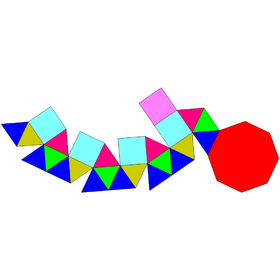Gyroelongated square cupola
| Gyroelongated square cupola | |
|---|---|
 |
|
| Type |
Johnson J22 - J23 - J24 |
| Faces | 3.4+8 triangles 1+4 squares 1 octagon |
| Edges | 44 |
| Vertices | 20 |
| Vertex configuration | 4(3.43) 2.4(33.8) 8(34.4) |
| Symmetry group | C4v |
| Dual polyhedron | - |
| Properties | convex |
| Net | |
 |
|
In geometry, the gyroelongated square cupola is one of the Johnson solids (J23). As the name suggests, it can be constructed by gyroelongating a square cupola (J4) by attaching an octagonal antiprism to its base. It can also be seen as a gyroelongated square bicupola (J45) with one square bicupola removed.
A Johnson solid is one of 92 strictly convex polyhedra that have regular faces but are not uniform (that is, they are not Platonic solids, Archimedean solids, prisms or antiprisms). They were named by Norman Johnson, who first listed these polyhedra in 1966.
The dual of the gyroelongated square cupola has 25 faces: 8 kites, 4 rhombi, and 8 quadrilaterals.
...
Wikipedia
